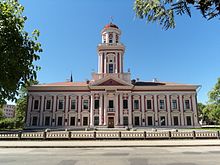Magnus Georg Paucker
Magnus Georg Paucker , also Magnus Georg von Paucker , ( Russian Магнус Георг фон Паукер ; * 15 November July / 26 November 1787 greg. In St. Simonis ; † 19 August July / 31 August 1855 greg. In Mitau ) was a Baltic astronomer and mathematician .
Paucker was the son of the pastor Heinrich Johann Paucker and studied astronomy, physics and mechanics at the University of Dorpat from 1805 under Georg Friedrich Parrot and Johann Wilhelm Andreas Pfaff . In 1808 he geodetically measured the course of the Embach in Livonia and in 1809, after completing his studies, he was involved in the construction of the optical telegraph line between Saint Petersburg and Tsarskoe Selo . After a short time as a senior teacher of mathematics in Vyborg , he became an observator at the observatory in Dorpat in 1811 (as the successor to Ernst Christoph Friedrich Knorre , who died in 1810) and gave lectures at the university there. In 1813 he received his doctorate under Johann Sigismund Gottfried Huth ( De nova explicatione phaenomeni elasticitatis corporum rigidorum , on elasticity theory ), but had already become an associate professor of mathematics in Dorpat. In August of the same year he gave up his university career (after he was passed over as assistant to the observatory in favor of Friedrich Georg Wilhelm Struve , who also received his doctorate under Huth in 1813) and became a senior teacher of mathematics and physics at the Mitau grammar school .
The high school had an extensive library and a small observatory. He stayed there for the rest of his career and in 1818 turned down an appointment as professor of astronomy in Dorpat. Paucker published numerous papers and in 1845 resigned his post as a high school teacher to devote himself entirely to research in mathematics, astronomy, metrology and other areas.
He corresponded with Carl Friedrich Gauß and in 1822 published a construction of the regular 257-corner with compass and ruler. Gauss had proven in the Disquisitiones Arithmeticae that such a construction is possible in principle, but only Paucker explicitly stated the formulas for the construction. The Jacobi student Friedrich Julius Richelot also published a construction in 1832.
In 1832 he received the first Demidow Prize for his book Handbook of Metrology in Russia and its German Provinces .
He was one of the founders (1815) and permanent secretary of the Kurland Society for Science and Art . In 1831 he was offered full membership in the Academy of Sciences in Saint Petersburg , but he turned it down because he wanted to stay in Mitau.
His first marriage in 1819 to Anna Christina Wilhelmine von Baggehufwudt from the Woibifer († 1835) family resulted in the sons Karl von Paucker (1820–1883) and Hermann von Paucker (1822–1889).
Fonts
- Geometric drawing of the regular seventeen and two hundred and fifty-seven corners in the circle , annual negotiations of the Courland Society for Literature and Art , Volume 2, 1822, pp. 160–219 ( online )
- The plane geometry of the straight line and the circle or the elements , First Book, Königsberg 1828
- Mémoire pour la construction géometrique des équations du troisième degré et sur les propriétés principales de ces équations, demontrées par la géométrie élementaire , Mémoires de l'Académie des sciences de St. Pétersbourg, Volume 10, 1846, pp. 158–266
- Metrology of the ancient Greeks and Romans , Dorpater Yearbooks for Literature, Statistics and Art, Volume 5, 1835, pp. 177-217
- The Weights and Measures of Russia and its Provinces , Schumacher's Jahrbuch 1836, 1837
- Foundations of Geometry , Part I to IV, Mitau 1842, Part V to VIII, Leipzig 1842
- The Gaussian equations of the triangle and two strange theorems of space , Mitau 1844
- The Bildlehre , Leipzig 1846
literature
- Ludwig Stieda : Paucker, Magnus Georg von . In: Allgemeine Deutsche Biographie (ADB). Volume 25, Duncker & Humblot, Leipzig 1887, pp. 240-242.
- Karin Reich , Elena Roussanova: Gauss correspondents in the Baltics , Preprint 2013, pdf
- Anonymous obituary in Tartu 1855
- Baltic Historical Commission (ed.): Entry on Paucker, Magnus Georg (v.). In: BBLD - Baltic Biographical Lexicon digital
| personal data | |
|---|---|
| SURNAME | Paucker, Magnus Georg |
| ALTERNATIVE NAMES | Paucker, Magnus Georg von; Паукер, Магнус Георг фон (Russian) |
| BRIEF DESCRIPTION | Baltic physicist |
| DATE OF BIRTH | November 26, 1787 |
| PLACE OF BIRTH | St. Simonis |
| DATE OF DEATH | August 31, 1855 |
| Place of death | Mitau |
